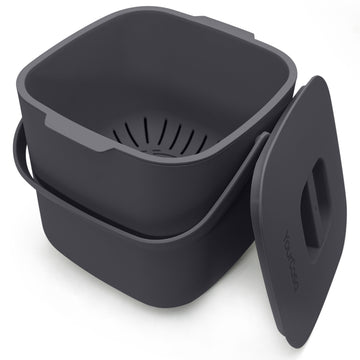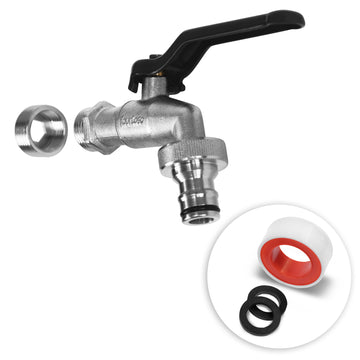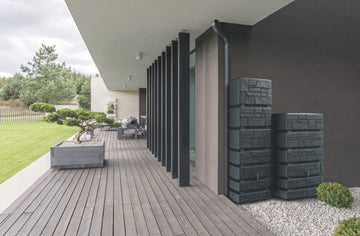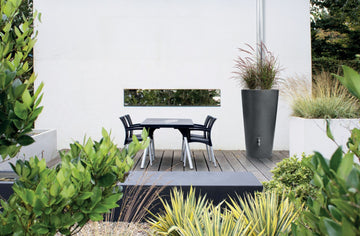Sustainable gardening: This is how rainwater use revolutionizes your garden
by Robert Zielinski on Feb 08, 2024

Using rainwater in the garden is an inconspicuous but big step towards more sustainability in your own household and a very simple approach to conserving resources. By collecting and using rainwater, you not only reduce your water consumption, but also ensure natural and plant-friendly irrigation of your garden.
What are the benefits of using rainwater in the garden? Using rainwater in the garden offers ecological and economic benefits. First, it is an environmentally friendly alternative to using drinking water for irrigation, which conserves natural resources and reduces the ecological footprint. Secondly, it can lead to cost savings as using collected rainwater reduces water bills. Furthermore, rainwater is often softer than tap water, which can be better for many plant species.
We will explain to you the benefits of using rainwater and how you can best approach this issue.
Why rainwater for your garden?
By using rainwater for environmentally friendly irrigation, you are giving your garden a great gift. The soft rainwater is completely free of lime and chlorine and is therefore particularly good for the health of your plants. In contrast to calcareous tap water, rainwater actively promotes the growth and resilience of plants.
Advantages of rainwater harvesting
Garden irrigation with rainwater offers many advantages. First of all, using rainwater instead of tap water has a positive effect on your water bill - an advantage that you will immediately notice. In addition, rainwater is more suitable for plants than treated, expensive drinking water because it is much richer in nutrients .
The use of rainwater also makes sense from an ecological point of view because it is collected and used directly on site - in contrast to tap water, which first has to be laboriously processed and transported. With rainwater, you not only water your garden more efficiently, but also in a more environmentally friendly way .
The advantages of using rainwater at a glance:
| Advantage | Description |
| Cost efficiency | Rainwater is a cost-effective alternative to tap water. |
| Better suitability for plants | Compared to treated drinking water, rainwater is significantly richer in nutrients. |
| Ecological benefits | Using rainwater reduces energy consumption for transportation and water treatment. |
| Increased efficiency in the garden | Allows for more efficient irrigation by utilizing natural resources. |
| Lower drinking water consumption | By using rainwater, less drinking water is consumed, which protects the environment. |
Environmental aspects and savings potential
By using rainwater in the garden, you can significantly improve your ecological footprint, as you use much less precious drinking water to irrigate your garden. This not only relieves pressure on natural water sources, but also reduces the burden on sewage treatment plants. Of course, switching to rainwater is also worthwhile for you personally - because your next water bill is guaranteed to be lower than the previous one.
The be-all and end-all: setting up a rainwater collection system
A rainwater collection system does exactly what the name suggests: it collects rainwater. It sounds easy, and it is. We'll explain how to set up a rainwater collection system for your garden . Here it is in a nutshell:
- Choose the right rain barrel (volume, material, design).
- Ideal positioning near gutters and downspouts.
- Connection to gutter and downpipe.
- Optionally install filters for leaves and dirt.
- Check the stability of the bin.
- Schedule regular maintenance and cleaning of the system.
- Now nothing stands in the way of sustainable garden care.
Choosing the right rain barrel
First you have to choose the right rain barrel. Factors that generally play a role are material, size and design. At YourCasa you will find a large selection of high-quality rain barrels in different sizes and with an attractive design for aesthetics in your garden. Our rain barrels are durable, robust and can withstand adverse weather conditions. The size of the bin depends on the size of your garden and local conditions, such as the expected rainfall in your area. The larger the garden and the higher the chance of rain, the larger your rain barrel should be.
Our models at a glance :
| Model | Volume (liters) | particularities | Price (€)* |
| YourCasa rain barrel 240 liters [Wave Design] | 240 | With tap, plantable lid | 109.99 |
| YourCasa rain barrel 290 liters [Premium] | 290 | With metal thread and lid, rotation process | 179.99 |
| Rain barrel 210/360/440 liters [amphora design] | 210/360/440 | With tap, plant bowl and lid | from 95.99 |
| YourCasa rain barrel 160/200 [including rain collector] | 160/200 | With downpipe connection set, with tap and lid | from 59.99 |
| YourCasa rain barrel 300 liters [StoneRain] | 300 | In stone look, with metal thread, child-safe lid, only 40cm deep | 324.99 |
| YourCasa rain barrel 240 liters [Seabreeze Flower] | 240 | Plantable lid design | 109.99 |
| YourCasa rain barrel 230 liters [Decore Design] | 230 | Plantable lid, with tap | 29.99 |
| YourCasa rain barrel 200 liters [EcoDrop] | 200 | Water drop design, with metal thread, rotation process | 159.99 |
| YourCasa rain barrel 200 liters [DualStyle] | 200 | Square and only 25 cm deep, with metal thread, 2 designs, rotation process | 239.99 |
| YourCasa rain barrel 280 liters [PureRain] | 280 | With metal thread and childproof lid, rotation process | 219.99 |
| YourCasa rain barrel 275 liters [SquareLux Rain] | 275 | Square and only 41 cm deep, plantable, rotation process, with metal thread, child-safe lid | 269.99 |
| YourCasa rain barrel 200 liters [PureFlow] | 200 | Filling from above, optionally plantable, rotation process, with metal thread | 274.99 |
| YourCasa rain barrel Aqua Silo | 350/450/650 | With lid, square and narrow, 4 ports | 149.99 |
| YourCasa rain barrel [EcoTower] | 260/720 | Square and narrow, with metal thread, rotation process | 219.99 |
| YourCasa rain barrel 230 liters [Slimline Nordic] | 230 | Square and narrow with a wood look, with metal thread, rotation process | 319.99 |
| YourCasa rain barrel 160 liters [AquaDesign Flower] | 160 | With metal thread and plant pot, design highlight, rotation process | 189.99 |
| YourCasa rain barrel 250 liters [Timber] | 250 | In wood look with metal thread and lid, rotation process | 189.99 |
| YourCasa rain barrel 230 liters [StoneRain] | 230 | Stone look, child-safe lid, rotation process | 169.99 |
| YourCasa rain barrel 150 liters [Aquaform Flower] | 150 | With metal thread and plant pot | 179.99 |
| Peruno – Modern rain barrel | - | Includes stand and 13-piece connection set | 129.99 |
| Tubo Tank 210, 320 liters | 320 | Stylish design, lid, metal thread, rotation process | from 229.99 |
| YourCasa rain barrel 250 liters [TwinView] | 250 | Square and narrow, wall tank | 220.00 |
| YourCasa rain barrel 280 liters [UrbanElegance] | 280 | With metal thread and lid, wall tank only 40 cm deep, rotation process, available in 5 colors | 399.99 |
| YourCasa rain barrel 210 liters [aqua shape] | 210 | Child-safe lid, metal thread, rotation process | 179.99 |
| Tower Stone: Modern rainwater storage | 350/500 | In stone look, with lid | from 209.99 |
*As of January 7, 2024; Prices may vary and are subject to change. For the latest information, visit the product catalog.

Installation and connection to the garden system
Ideally, you should place your rain barrel in a location that is close to the plants and beds that will be watered. Of course, at this point you should also have the option of connecting the barrel to the downpipe of your gutter so that as much rainwater as possible ends up in it. Make sure that you place the bin on stable and flat ground to avoid it tipping over later.
Filtering and treatment of the water
Before you use the collected rainwater to water your plants, you should filter and treat it. A good filter will help remove leaves, dirt and other contaminants. Not only will you prevent your irrigation system from becoming clogged over time, but you will also ensure that your plants receive clean water.
Rainwater in use: tips and tricks
So far we have primarily written about the use of rainwater for irrigation - but there are also other possible uses. Below you will find out what these are and what advantages they bring with them.
Watering plants and beds
First, however, let's come back to watering your plants and beds - because this is definitely the main area of use for the collected rainwater . Watering your plants and beds with rainwater is not only environmentally friendly, but also particularly gentle on plants. The rainwater used is soft and contains no additional chemicals - so you also protect the wildlife in your garden. Of course, you should still make sure to adapt the irrigation to the respective plant species. It is also extremely important to use the right soil so that the water reaches the roots of the plants and supplies them with the necessary nutrients and minerals.
Cleaning and other possible uses
You can also use the water collected in the rain barrel for other purposes - for example to clean your garden and outdoor areas . You can easily wash garden furniture, tools and even your car with rainwater - saving valuable tap water. Another plus point: unlike tap water, rainwater does not leave behind any limescale deposits, which makes it ideal for caring for surfaces such as the paint on your car. Rainwater is also ideal for filling water features or bird baths in the garden.
Maintenance and care of your rainwater system
A rainwater system also needs to be maintained - otherwise problems such as clogged pipes or contaminated water can arise after a short time. To ensure that your rainwater harvesting systems stay as new in the long term , we will give you a few tips.
Regular inspection and cleaning
To ensure that your rainwater harvesting system continues to function properly after months and years and provides high water quality for human use, you should take a look at it regularly and remove any kind of contamination as quickly as possible.
When cleaning, you can proceed as follows:
- Empty the rain barrel: Empty the rain barrel completely to expose any dirt.
- Remove Dirt and Debris: Remove leaves, dirt, and other debris using a brush and/or pressure washer.
- Clean the filter: If you have a filter, you should also remove it and clean it carefully, for example using a soft brush.
- Clean lines and pipes: To keep your system clean for longer, you should also clean lines and pipes.
- Disinfection: To prevent algae formation and bacterial growth, you can use a mild disinfectant solution.
- Rinse the barrel: Finally, rinse your rain barrel again to remove any remaining dirt and disinfectant residue.
Winterizing and maintenance
To ensure that your rain barrel survives the winter undamaged , you should empty it before the first frost. The same applies to cables and pipes.
If you have other problems such as algae buildup or notice an unpleasant smell coming from your bin, it is important to act quickly . Clean the rain barrel immediately to prevent further algae from forming and settling.
Conclusion and future outlook
When you water your garden with rainwater, you not only do something for the environment, but also for your wallet. With the rain barrels from YourCasa you can also ensure an attractive outdoor area .
By the way: The YourCasa range not only offers rain barrels , but also accessories , kitchen composters and rubbish bins - and is constantly being expanded. Please feel free to visit our online shop again in the future.

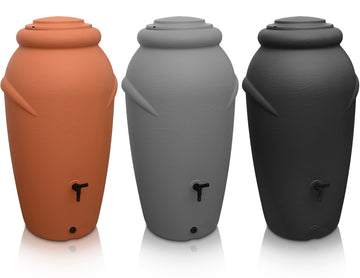
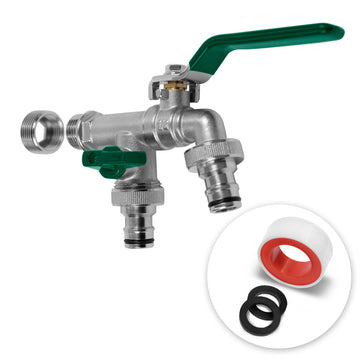
![Drei hohe YourCasa Regentonne 240 Liter [Wellen-Design] - Frostsicher & UV-beständige Gartentöpfe in den Farben Schwarz, Grau und Terrakotta, jeweils mit Drainagesystem für nachhaltige Bewässerung.](http://yourcasa.de/cdn/shop/files/ohnelogo_b8aeecac-557e-4106-a999-e77dcd160209.jpg?v=1707130230&width=360)
